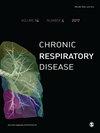身体活动监测在临床呼吸试验中现场行走测试质量保证方面的未开发潜力
IF 2.3
3区 医学
Q2 RESPIRATORY SYSTEM
引用次数: 2
摘要
在临床研究试验和包括肺部康复在内的常规临床服务评估中,基于实地的步行测试是公认的结果衡量标准。尽管广泛使用,但很少关注或报告这些测试的质量保证。身体活动监测越来越受欢迎,来自活动监测器的数据可用于现场步行测试的质量保证。我们在这篇文章中提供了使用这种方法可能获得的数据驱动见解的例子,使用来自腰部磨损加速度计的数据,用于增量穿梭行走测试(ISWT)、耐力穿梭行走试验(ESWT)和六分钟行走测试(6MWT)。考虑到测量身体活动的设备众多,以及描述身体活动的范围指标,我们还评论了使用活动监测器来保证步行测试质量的一些技术考虑因素。数据驱动的质量保证方法在临床呼吸试验的其他结果测量中已经很常见,但对这种基于现场的步行测试方法知之甚少。身体活动监测的应用可以扩展到其他基于现场的锻炼测试和额外的康复服务。这对于像6MWT这样的自定步行走测试来说可能更具挑战性。未来的工作应将这种方法应用于研究试验和服务评估,以探索基于场地的步行测试质量对表现(如ISWT上的距离或ESWT实现的时间)、对干预措施的反应性(如肺部康复)和训练程序的有效性(如多场地试验的远程训练)的影响。本文章由计算机程序翻译,如有差异,请以英文原文为准。
The untapped potential of physical activity monitoring for quality assurance of field-based walking tests in clinical respiratory trials
Field-based walking tests are well-established outcome measures in clinical research trials and in the evaluation of routine clinical services, including pulmonary rehabilitation. Despite widespread use, there has been little attention to, or reporting of, the quality assurance of these tests. Physical activity monitoring has become increasingly popular and data from activity monitors could be used for quality assurance of field-based walking tests. We provide examples in this article of data-driven insights possible with this approach, using data from waist-worn accelerometry, for the incremental shuttle walking test (ISWT), endurance shuttle walk test (ESWT) and six-minute walk test (6MWT). Given the multitude of devices to measure physical activity and the range metrics to describe physical activity, we also comment on some of the technical considerations to using activity monitors for walking test quality assurance. Data-driven approaches to quality assurance are already commonplace for other outcome measures in clinical respiratory trials, but little is known about this approach for field-based walking tests. The application of physical activity monitoring may be extended to other field-based exercise tests and additional rehabilitation services. This may be more challenging for self-paced walking tests such as the 6MWT. Future work should apply this approach to research trials and service evaluations to explore the impact of field-based walking test quality on performance (e.g. distance on the ISWT or time achieved for the ESWT), responsiveness to interventions (e.g. pulmonary rehabilitation) and effectiveness of training procedures (e.g. remote training for multi-site trials).
求助全文
通过发布文献求助,成功后即可免费获取论文全文。
去求助
来源期刊

Chronic Respiratory Disease
RESPIRATORY SYSTEM-
CiteScore
5.90
自引率
7.30%
发文量
47
审稿时长
11 weeks
期刊介绍:
Chronic Respiratory Disease is a peer-reviewed, open access, scholarly journal, created in response to the rising incidence of chronic respiratory diseases worldwide. It publishes high quality research papers and original articles that have immediate relevance to clinical practice and its multi-disciplinary perspective reflects the nature of modern treatment. The journal provides a high quality, multi-disciplinary focus for the publication of original papers, reviews and commentary in the broad area of chronic respiratory disease, particularly its treatment and management.
 求助内容:
求助内容: 应助结果提醒方式:
应助结果提醒方式:


